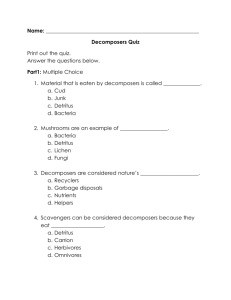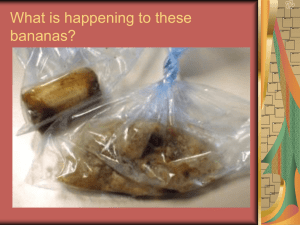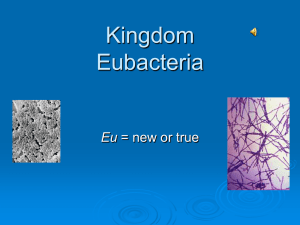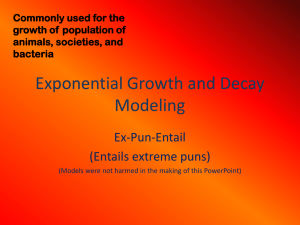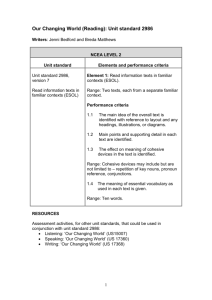Prokaryotes Play a crucial role in the biosphere (27
advertisement
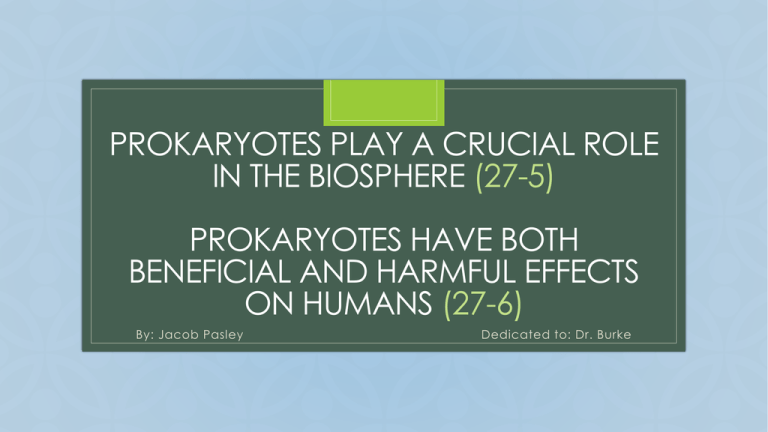
PROKARYOTES PLAY A CRUCIAL ROLE IN THE BIOSPHERE (27-5) C PROKARYOTES HAVE BOTH BENEFICIAL AND HARMFUL EFFECTS ON HUMANS (27-6) By: Jacob Pasley Dedicated to: Dr. Burke Prokaryotes Intro • Singled cell organism • Lack membrane bound nucleus • Two major classification domains: the bacteria and archaea • Founds in all types of habitats • Many create large colonies • Reproduce through Asexual reproduction; typically by binary fission • Involves horizontal gene transfer • transfer of genes that is not typical reproduction • Four main structures or shapes 1. 2. 3. 4. Cocci- spherical Bacilli- rod shaped Spirochaete- spiral-shaped Vibrio- comma shaped Decomposers • Organism(s) that break down other organisms; they are heterotrophic • Heterotrophic- use organic substrates to get energy, carbon, and nutrients for processes and • Breaks down cells • Convert tissues into metabolically useful chemical products • No need for internal digestion; thus no technical “stomach” • Use dead organisms and non living organic compounds as a food source Types of Decomposers • Bacterial/Bacteria • • • • • Can break down mostly any type of organic matter 1 gram of soil contains 40 million bacterial cells More bacterial than plants or animals combined; large biomass Vital in recycling nutrients Used in nutrient cycle(s) • Fungi • • • • • Most grow in branching network(s) of hyphae Can penetrate large pieces of organic matter unlike bacteria Primary decomposers in the woods Releases enzymes that breakdowns decaying material Hyphae is used to breakdown matter and absorb corresponding nutrients • When two fungi’s hyphae grow close to each other they fuse to form other fungi as well Types of Decomposers (2) • Worms • • • • (contains slugs and snails) Can be considered decomposers and also scavengers A worm can remove the skin or various tissues to sped up decay Can expose the elements or to other decomposers Filers soil; filters out nutrients Video Overall Importance of Decomposers • Decomposers help plants receive the nutrients necessary for vital life processes • Dead waster would pile up and matter would not decay • Assists with Nitrogen Fixation • where atmospheric nitrogen is filtered into organic compounds (assisted, in part, by decomposers) • Adds usable nitrogen Types of Symbiosis •Three types of Symbiosis • Mutualism- both benefit • Commensalism- one benefits with little effect on the host • Parasitism- one benefits at the coast of the host • Means a relationship between 2 or more organisms Symbiosis Video Pathogens • (Can) produce disease • It means “Infectious Host” • Known as a microorganism (can include a virus, bacterium, prion, or fungus) • One of three P’s (predators, pathogens, and parasitoids) • Beneficial in the sense that they can serve as biological controls and suppress various (arthropod) pest populations Pathogenic Prokaryotes • Prokaryotes cause ½ of human disease • This includes (famously) Lyme Disease • Types • Prior- infectious pathogens that do not include nucleic acids and abnormally folded proteins • Viral • Bacterial- often killed by antibiotics, though resistance is an issue • Fungal- usually saprophytes; common cause of disease in crops and plants • Other Parasites- such as protists and helminths • However, can be used in healthcare in vaccinations as well • Makes the immunity stay virulent against disease Mutualistic Bacteria • Mutualistic relationships exist between humans and bacteria. • the human intestine and digestive systems contains up to 1,000 different species of bacteria • 10 times more abundant than the total number of cells in the human body • Benefits: bacteria can help digest (break down) food that the intestine can not efficiently digest • Bacteria in the human digestive system (and other digestive systems) also contain genes associated with nutrients, vitamins, and carbohydrates (and synthesis processes) Mutualistic Bacteria (2) • Gut (intestinal bacteria) sends signals that allows humans to produce antimicrobial compounds • Probiotic- dietary supplement that contains live bacteria (ACTIVA) • Most bacteria are beneficial • Examples • Lactobacillus reuteri- protects human(s) from the effect(s) of microbes, lowers cholesterol, and assists with the immune system • Bacterial Flora- present in the human gut/ digestive system Pathogenic Bacteria • Cause bacterial infection • Very few are pathogenic (infectious) •Examples •Tuberculosis- caused by Mycobacterium tuberculosis • Kills 2 million people each year •Pneumonia- caused by bacteria such as Streptococcus and Pseudomonas Endotoxins • A toxin that is present in the bacteria when a cell disintegrates • Detailed by Richard Friedrich Johannes Pfeiffer • In the cell, released only after the cell wall disintegrates • Associated with lipopolysaccharide(s) and Gram-negative bacteria • Some studies show endotoxins in the digestive system can cause obesity Exotoxins • Can cause damage to the host cell by destroying it or disrupting cellular metabolism • May be released during the lysis of the cell • Lysis- breaking down of the cell • Can be destroyed by heating • So toxic that it can kill the host before the immune system can respond • A toxin that is released into the environment ***Note: both endotoxins and exotoxins are ways of enducing disease Prokaryotes in Research • Have led to important advances in DNA research and technology • Bioremediation • The use of these organisms to remove pollutants from the environment • Used for • Mining • Synthesis of vitamins • Production of antibiotics, hormones, and other products ***Note: just and overview: video will provide further insight
